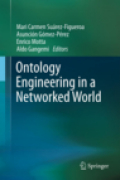
Ontology engineering in a networked world
Suárez-Figueroa, Mari Carmen
Gómez-Pérez, Asunción
Motta, Enrico
Gangemi, Aldo
The Semantic Web is characterized by the existence of a very large number of distributed semantic resources, which together define a network of ontologies.These ontologies in turn are interlinked through a variety of different meta-relationships such as versioning, inclusion, and many more. This scenario is radically different from the relatively narrow contexts in which ontologies have been traditionally developed and applied, and thus calls for new methods andtools to effectively support the development of novel network-oriented semantic applications. This book by Suárez-Figueroa et al. provides the necessary methodological and technological support for the development and use of ontologynetworks, which ontology developers need in this distributed environment. After an introduction, in its second part the authors describe the NeOn Methodology framework. The book’s third part details the key activities relevant to theontology engineering life cycle. For each activity, a general introduction, methodological guidelines, and practical examples are provided. The fourth partthen presents a detailed overview of the NeOn Toolkit and its plug-ins. Lastly, case studies from the pharmaceutical and the fishery domain round out the work. The book primarily addresses two main audiences: students (and their lecturers) who need a textbook for advanced undergraduate or graduate courses on ontology engineering, and practitioners who need to develop ontologies in particular or Semantic Web-based applications in general. Its educational value is maximized by its structured approach to explaining guidelines and combining them with case studies and numerous examples. The description of the open sourceNeOn Toolkit provides an additional asset, as it allows readers to easily evaluate and apply the ideas presented. Provides structured guidelines for Semantic Web application development and ontology engineering. Combines sound methodologies with numerous examples and real-world case studies. Allows readers to easily evaluate and apply methodologies through the open source NeOn toolkit. Serves as a textbook for graduatecourses as well as a state-of-the-art overview and guide for practitioners. INDICE: Introduction: Ontology Engineering in a Networked World. The NeOn Methodology for Ontology Engineering. Pattern-based Ontology Design. The NeOn Ontology Models. Ontology Requirements Specification. Reusing and Re-engineering Non-ontological Resources for Building Ontologies. Ontology Development by Reuse. Ontology Localization. Ontology (Network) Evaluation. Modularizing Ontologies. Ontology Evolution. Methodological guidelines for matching ontologies.Overview of the NeOn Toolkit. Scheduling ontology engineering projects using gOntt. Customizing your interaction with Kali-ma. Visualizing and Navigating Ontologies with KC-Viz. Reasoning with Networked Ontologies. Knowledge management at FAO: a case study on network of ontologies in fisheries. Electronic Invoice Management in the Pharmaceutical sector: The PharmaInnova case. Integrating product information in the pharmaceutical sector.
- ISBN: 978-3-642-24793-4
- Editorial: Springer Berlin Heidelberg
- Encuadernacion: Cartoné
- Páginas: 490
- Fecha Publicación: 31/01/2012
- Nº Volúmenes: 1
- Idioma: Inglés
